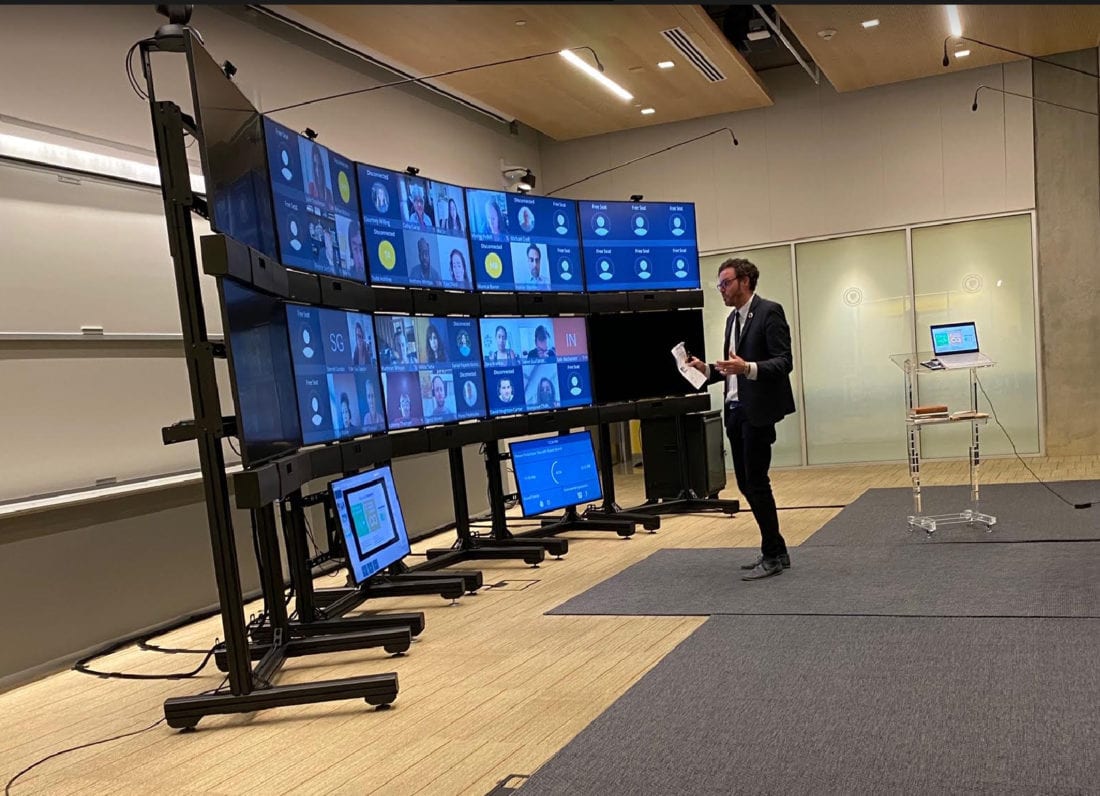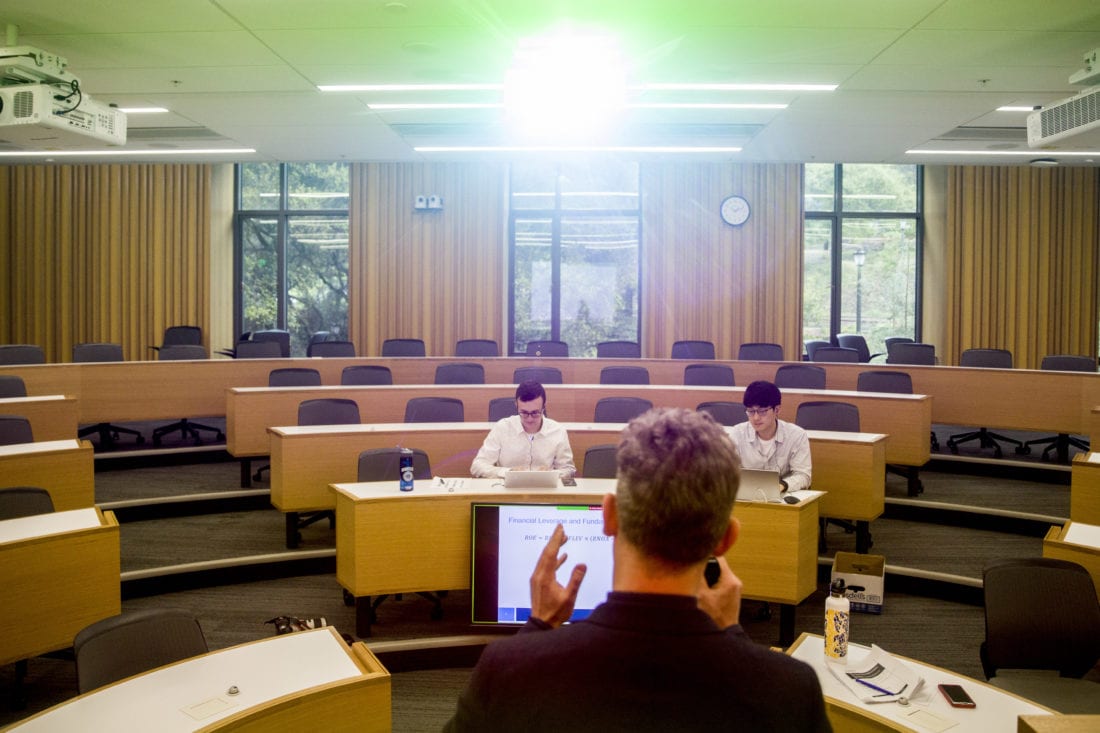
Berkeley Haas faculty spent the summer with a ticking clock and a lofty challenge: to pull apart their courses and rebuild them to give students as rich an experience as possible, during a maddeningly uncertain time.
“It’s an interesting challenge—how to take what’s different about this environment and improve teaching,” said Finance Prof. Terry Odean. “One of the big challenges for the fall semester is helping students feel like they are part of the class, part of the school, and part of a group of students.”
It’s an interesting challenge—how to take what’s different about this environment and improve teaching. —Prof. Terry Odean
When students begin class this month, they’ll benefit from the hundreds of hours Odean and the rest of the Haas faculty have spent on redesigning their classes with a single goal in mind: creating a top-notch academic experience focused on maximizing student engagement.
Working to match, and potentially improve upon, some aspects of the engagement level of a live, physical classroom online is no easy feat. It has involved hours of brainstorming, planning, workshop training, and major investments in a host of new technologies to reinvent instruction. It’s been all hands on deck: Dean Ann Harrison said she’s proud of the work the faculty, graduate student instructors, and the Haas Digital and Exec Ed Digital teams have done over spring and summer. “After watching last spring when our faculty and staff moved within 36 hours to online teaching when the coronavirus broke out, I believe there’s little that we can’t do virtually going forward,” Harrison said. “Their hard work has opened up so many other opportunities for the future of teaching at Haas.”
A different experience
“We’re very excited to debut what we’ve learned and implemented,” added Prof. Catherine Wolfram, associate dean for academic affairs & chair of the faculty, who is overseeing the transition with Prof. Jennifer Chatman, associate dean for learning strategies, and Jay Stowsky, senior assistant dean for instruction. “I think this will be many cuts above what students saw in the spring, and they’ll be pleasantly surprised,” Wolfram said.
While Berkeley’s fall semester officially begins on Aug. 24, students in the evening and weekend MBA program started their first classes last week. Andrew Celin, MBA 22, said he enjoyed his first class taught by Assoc. Prof. Jose Guajardo from one of the classrooms at Chou Hall upgraded for virtual teaching.
“The difference in learning experience was immediately evident, and I think it put everyone into the mindset that we were truly in class and not on a webinar call,” he said. “The camera was following Prof. Guajardo around the room as he moved and used different whiteboards. Having the option to simultaneously view a slide and see the professor at the whiteboard added tremendously to understanding and keeping students engaged after a full day’s work.”
Here are details of some of the innovations:
- Launching virtual classrooms: The school has improved existing classrooms and invested in four new state-of-the-art “virtual classrooms” in conjunction with UC Berkeley Executive Education. Two of the classrooms will be used for executive education programs, and two by the MBA programs for core classes. The setup includes multiple cameras installed at various angles, allowing students to choose their view of the instructor; a digital whiteboard which instructors can use in person and students can write on remotely; and a curved wall of high-resolution monitors and directional speakers where the instructor can see and hear up to 84 students at once. Mike Rielly, CEO of Berkeley Executive Ed, said these virtual classrooms were designed to simulate a live classroom environment as closely as possible. Senior Lecturer Homa Bahrami of the Management of Organizations Group said the setup works well for her because she can easily use a whiteboard and move around while she teaches. “It creates intimacy,” she said. “I can walk up to students and engage with them.” In addition to the four new virtual classrooms, faculty can also host Zoom classes from Chou Hall classrooms that have undergone technical upgrades for virtual teaching. Instructors have access to automated cameras, high-speed internet, and all the traditional aspects of a classroom, and they can see students on newly installed large monitors.
- Creating small student groups to engage with professors: To increase engagement, small groups of students will have the opportunity to meet weekly with a faculty member for a one-hour check-in. Half the ladder faculty have already signed on to participate in this new Faculty-Student Engagement Series (FSES), which invites students to discuss anything from current events to the faculty member’s research to how students are coping with shelter-in-place, Chatman said. “The goal, in lieu of the fact that there won’t be in-person interactions between students and faculty, is to really get to know that faculty member,” Chatman said. Bill Pearce, the Haas chief marketing officer and a professional faculty member in the Marketing Group, scheduled more than 100 individual Zoom meetings with students between mid-March and May. Going forward, he said the Faculty-Student Engagement Series will be a valuable additional way to replace the time before or after class students often spent with faculty before the pandemic.
- Investing in high-quality asynchronous content: Faculty have invested many hours in improving the production quality of the lectures they are recording (lighting, sound, and graphics), Chatman said. In the “flipped classroom” approach that is considered a best practice for online instruction, students are typically asked to watch lectures in advance and to be prepared to discuss the content, take quizzes, or move into breakout groups during class time. Odean, a veteran of online content creation, built a home studio, with special lighting and cameras, where he filmed the 50 videos he uses with his course. “It’s a lot of work, a shocking amount of work,” said Odean.
- Applying learnings from workshops to online teaching: Over the summer, more than 120 faculty members, GSIs and staff took part in four different workshops offered by the Haas Digital team—ranging from beginner to advanced levels. Haas Digital Executive Director Sara Sieteski said her group’s goal was to help the faculty improve student engagement, no matter what their level of online expertise. Key to that success, she said, was getting them to think about a live session as if it were a radio program. “Every minute is scripted out,” she said. “Dead air kills a class just like dead air kills radio.” To that end, faculty members will be relying more than ever on their graduate student assistants (GSIs), who are key to making classes flow smoothly—reading student questions from the chat, making sure students are called on, and helping with online quizzes and polls.
- Zooming, with all the bells and whistles: In Haas Digital workshops and at home, faculty have been learning how to use Zoom features more effectively to break up classroom time. “The one issue that I am concerned with going into the classes is what we are calling ‘Zoom fatigue,’ said Shruti Sethi, EWMBA 23, who starts classes Aug. 8. To combat fatigue, faculty will be adding more games and simulations, and more class time devoted to discussions rather than lectures, Chatman said. Veselina Dinova, a professional faculty member who teaches finance, said she’s using the breakout rooms more to allow students to get to know each other and discuss specific topics in a small group before opening up discussion with the whole class after the breakout session. She also uses breakout rooms for breaks that allow students to catch up personally. “The feedback has been overwhelmingly positive,” she said. In addition, a new instructional designer, expected to join Haas Digital this month, will work with faculty to add more sophisticated data visualizations to MBA courses. The designer will use Jupyter notebooks, a web-based interactive platform created at UC Berkeley. Prof. Don Moore said he’s already reached out to Sieteski, asking about how he can work with the designer on simulations for his courses.

While the Haas School has made significant investments in new technology and training, virtual teaching at Haas isn’t new. Prof. Cameron Anderson pioneered an online version of his popular course Power & Politics in 2012. Since then, he has worked continuously to improve the online version—the latest version, created with Haas Digital, is now the most in-demand elective in the EWMBA program—and has shared his best practices with other faculty members.
Anderson uses online discussion forums, which make up almost a third of the course. “It forces students to think through these issues really deeply in a way that doesn’t happen as often in my in-person class,” he said. “Because of that deeper, critical thinking, I still think my online students learn a bit more than my in-person students.”
It forces students to think through these issues really deeply in a way that doesn’t happen as often in my in-person class. —Prof. Cameron Anderson
There are also big benefits for students who are more reticent in traditional settings, he says. “In a normal classroom, 20% to 30% of the students do almost all the talking,” he said. “In the online class, everyone is chiming in, and I try hard to respond to as many as I can.”
Even so, online teaching can never fully replace the in-person experience, which many students—and faculty—crave, Anderson said. The goal is to return to a hybrid approach that blends online lectures with small-group, in-person discussions as soon as state and local authorities approve.
In the meantime, Haas is “maximizing and taking advantage of things that we can do as a small school,” Wolfram said.